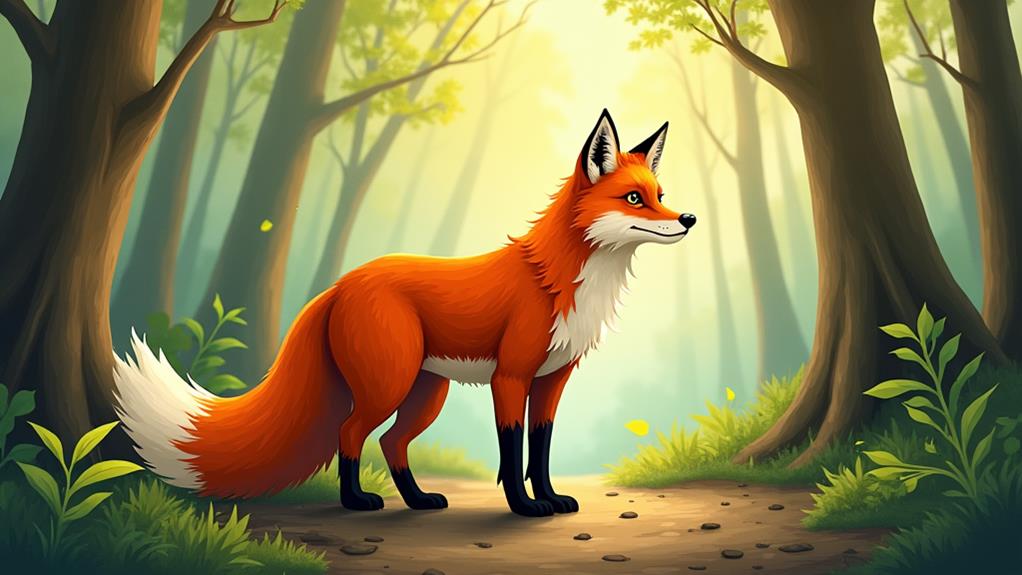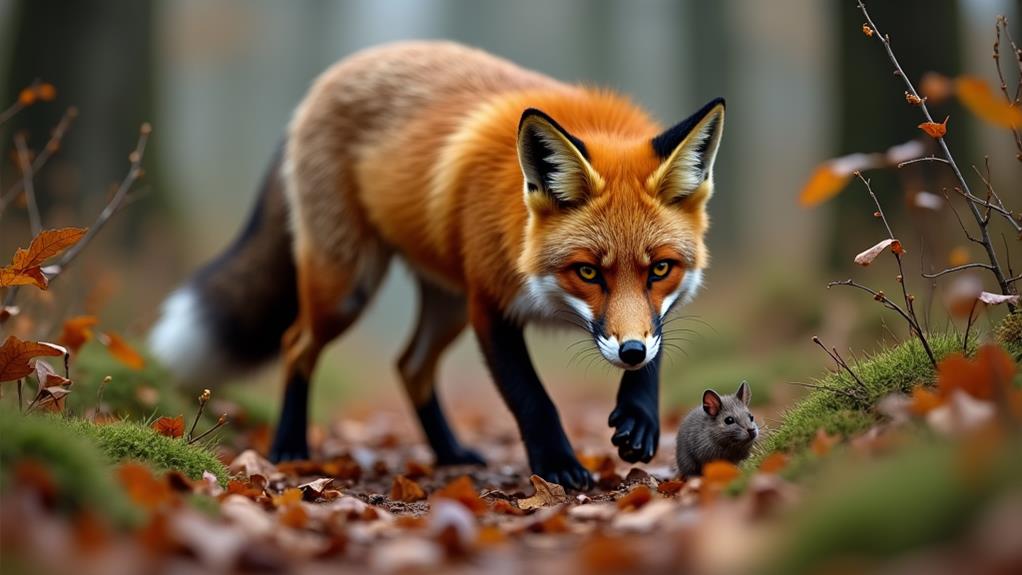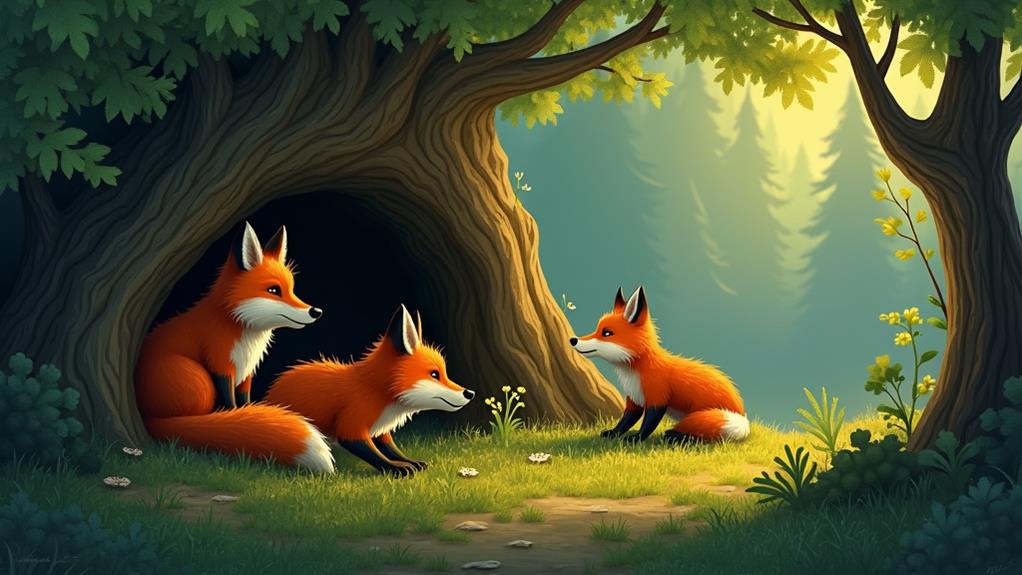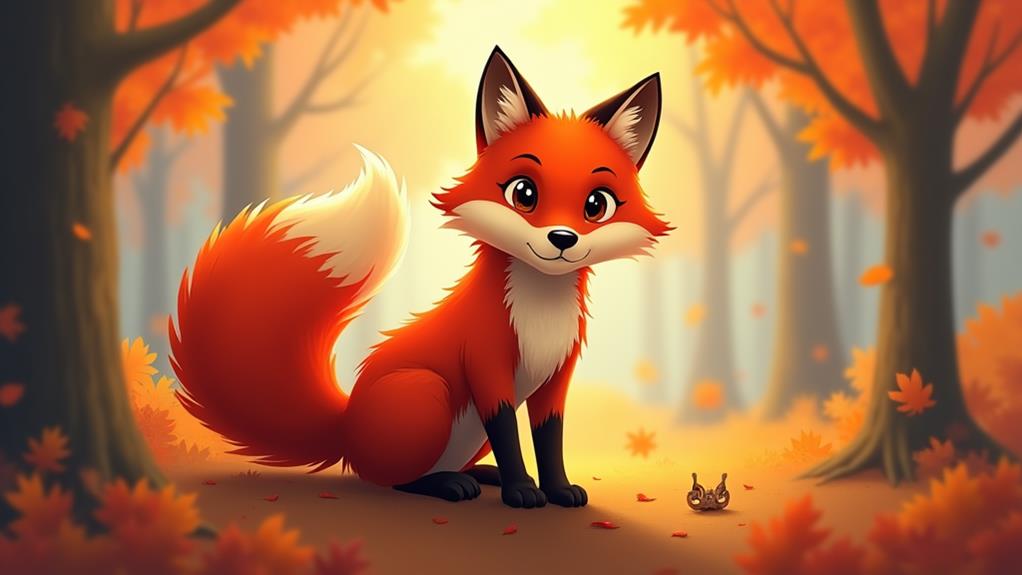Red foxes are more than just adorable backyard visitors; they're pretty remarkable creatures! Did you know they can weigh between 8 to 15 pounds and have coats in various colors, like grey and even white? These clever animals thrive in diverse habitats, from forests to urban neighborhoods. With exceptional hearing, they can detect prey up to 100 feet away! Fox kits, born blind and totally helpless, learn from their parents through playful antics. Their fascinating social structure includes about 40 vocal sounds and some serious scent-marking. Stick around, and you'll uncover even more surprises about these cunning little creatures!
Contents
Physical Characteristics of Red Foxes

Red foxes often exhibit striking physical characteristics that set them apart from other canids. You can't help but notice their beautiful reddish-orange coat, which is like a warm blanket on a chilly day.
But did you know they come in various color variations, too? You might spot grey, blackish-brown, platinum, amber, or even white morphs on these furry friends! Their adaptability to different environments, including urban settings, showcases their resilience.
These charming creatures weigh between 8 to 15 pounds and can stretch 17 to 35 inches long—not counting their bushy tail, which can measure a whopping 16 inches!
Their pointed ears aren't just for show; they perk up to enhance their already fantastic hearing, making them excellent hunters. Plus, those long whiskers help them navigate on moonlit nights as they scurry about.
Red foxes also boast some impressive agility. With forepaws sporting five digits and back paws featuring four plus an extra toe, they've got balance down to an art.
Their retractable claws, similar to a cat's, let them maintain traction on slippery surfaces. So whether you're admiring their beauty or marveling at their nimbleness, red foxes are truly enchanting creatures!
Habitat and Distribution
The habitat and distribution of the red fox are truly remarkable, as these adaptable creatures can be found across a vast range that includes forests, grasslands, mountains, and even urban neighborhoods.
Red foxes inhabit a variety of environments, demonstrating their resilience and ability to thrive in diverse habitats, including mixed landscapes with changeover zones. They're the most widespread carnivorous mammals, thriving in diverse environments from the wilds of North America to the bustling streets of cities around the globe.
You might be surprised to learn that they've staked their claim in human surroundings—those clever critters can often be spotted in gardens, parks, and even napping under your porch!
Their adaptability is a fascinating part of their success. While urban environments pose challenges like habitat loss, red foxes manage to maintain a cozy home by seeking out plentiful food sources.
You see, they've got a knack for locating spots rich in snacks, which leads to higher populations in areas that highlight a blend of nature and human living. They really know how to make the best of both worlds!
Diet and Hunting Techniques

When you think about the red fox, picture a clever little hunter on the prowl.
These crafty critters have a diverse menu, munching on everything from rodents to berries, which makes them adaptable to their surroundings. Their opportunistic feeding habits allow them to thrive in various environments, including urban settings where they can scavenge human food waste, showing their remarkable urban adaptation and population growth.
With sharp ears and sneaky moves, they're like the ninjas of the animal kingdom—except instead of throwing stars, they've got a knack for catching dinner!
Hunting Methods
A skilled hunter, the red fox employs a variety of techniques and a diverse diet to thrive in different environments. You might be surprised to learn just how adaptable these clever creatures are!
With their exceptional hearing, red foxes can detect a tiny mouse squeak from as far away as 100 feet. That's like hearing a whisper in a crowded room!
One of their signature hunting methods is known as "mousing." They stalk their prey with stealth and pounce just like a ninja!
Red foxes are also smart enough to use the Earth's magnetic field to improve their accuracy, making them even more successful hunters. Their omnivorous diet includes small mammals, birds, fruits, and insects, which means they can eat almost anything. Talk about being versatile!
And here's a fun fact: red foxes practice food caching. Ever seen them bury leftovers? This behavior allows them to save some snacks for leaner times, ensuring they won't go hungry later.
Food Preferences
Diving into the food preferences of red foxes reveals just how adaptable these clever animals are in their eating habits. You might be surprised to learn that red foxes have an omnivorous diet, enjoying a mix of small mammals, birds, fruits, and even insects.
These opportunistic eaters know how to make the most of their surroundings!
When it comes to hunting, red foxes employ a fascinating technique called "mousing." They stalk their prey and then pounce, thanks to their exceptional hearing, which lets them detect sounds from up to 100 feet away.
Their hunting strategy is all about stealth and agility, allowing them to dart through various environments with ease.
But here's a fun twist—red foxes can cache food, hiding it away for those leaner days when a snack is hard to come by. With their keen sense of smell and vision, they're like culinary detectives, locating food even when it's buried under snow or hidden in dense vegetation.
Social Structure and Communication
Red foxes show a fascinating blend of social behavior and communication methods that contribute to their adaptability in the wild. While you might think of them as solitary creatures, during the breeding season and when rearing pups, they actually form small family units, often called a skulk or leash.
In these tight-knit groups, you'll notice social hierarchies emerging, particularly among playful young kits who engage in fun interactions that help build strong bonds.
When it comes to communication, red foxes are incredibly clever. They use a range of vocalizations—about 40 different sounds, including barks and screams. Each sound helps them express needs or feelings, making their social interactions rich and varied.
Scent marking is another critical strategy; those musty scents from glands at the base of their tails inform other foxes who's boss and what territory belongs to whom.
These vibrant creatures employ their body language along with vocalizations to protect their territory from intruders. It's a clever way to communicate that they mean business, while still embracing the playful spirit of family life.
When you observe them, you can't help but appreciate their unique and engaging ways!
Reproduction and Lifespan

When it comes to reproduction, red foxes get busy in winter, usually between January and March.
After a quick gestation of about 52 days, the female, or vixen, gives birth to a litter of 4 to 6 kits that are as blind as a bat and rely completely on their parents for everything.
As these little bundles of fur grow, they stick around for about seven months, soaking up essential survival skills before they set off to find their own homes—talk about a tough parenting gig!
Breeding Season Timing
During the winter months, typically from January to March, red foxes enter their breeding season, a time marked by energetic courtship behaviors.
You'll witness the male and female foxes engaging in playful interactions, setting the stage for their exciting future. After a gestation period of about 52 days, by mid-April, vixens give birth to a litter of 4-6 adorable kits.
Picture those little furballs, born blind and totally dependent on their parents!
Here are a few key points about their breeding season:
- Shared Responsibilities: Both the male (dog) and female (vixen) actively participate in parenting. They hunt and care for their young together, making quite the team!
- Territorial Claims: During this time, red foxes also establish and defend their territories to guarantee a safe space for their family.
- Kit Development: Young kits stay with their parents for about seven months, learning the ropes before heading off to establish their own territories.
Isn't it fascinating how these clever creatures balance love and survival?
The bond between red foxes during this breeding season reveals so much about their enchanting lives!
Kit Development Stages
The journey of a red fox kit from birth to independence is truly remarkable. After a gestation period of about 52 days, the kits—usually around 4 to 6 of them—are born blind. For those first essential weeks, they're entirely dependent on their caring parents, the male (dog) and female (vixen), who are busy raising their young and providing nourishment.
It's a full-time job that showcases the depth of their dedication!
As the kits grow, they begin to explore their surroundings. This is where the fun really starts. Over the next seven months, they learn crucial survival skills. Imagine little kit foxes practicing their pouncing and hiding—adorable, right?
This playful training isn't just for show; it prepares them for a life of independence and territory establishment.
In the wild, red foxes have an average lifespan of 3 to 4 years, but they can live up to 14 years in captivity. While their time may seem short in the wild, these kits pack in learning, love, and plenty of mischief that makes their journey all the more enchanting.
Conservation and Subspecies
Conservation efforts for the red fox are vital, especially given the various subspecies facing unique challenges. You mightn't know that red foxes have 45 recognized subspecies, each needing special attention. Among these, the critically endangered Sierra Nevada red fox has only about 50 individuals left!
The stakes are high, and here's what's at risk:
- Korean Fox: Threatened by habitat loss and poaching, it's struggling to survive.
- Human-Wildlife Conflicts: Urbanization can lead to dangerous encounters, making it tough for both foxes and people.
- Habitat Preservation: Keeping their homes safe is essential for maintaining ecological roles.
Despite being classified as Least Concern by the IUCN Red List, localized populations still face significant threats.
That's why conservation efforts focus on habitat preservation, educating you about their ecological roles, and reducing conflicts. The inspiring recovery of island fox populations in California shows the positive change we can create with dedicated programs.
Final Thoughts
So there you have it—the red fox, a clever critter with a flair for survival! From its sleek, fiery coat to its nimble hunting skills, this animal is truly a marvel of nature. Whether you spot one darting through the woods or lounging in a sunbeam, remember they're more than just a pretty face. They're resourceful, playful, and a little bit mischievous, just like your favorite childhood friend. Let's celebrate the red fox and all its fascinating quirks!














